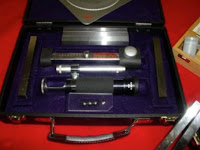 |
| Portable Hardness Testing Kit |
Hardness testing is an easy and informative test to learn important information about material properties. For most general applications, hardness can be described as the property a material has to resist indentation. In
welding, its important to measure hardness of
welds for quality and material compliance.
Various methods and procedures are used to measure hardness. One method is to create a "dent" on a target material (under controlled conditions) and then carefully measure the resulting indentation. The indentation correlates directly to the hardness of the material. In very general terms, the smaller the mark, the harder the material, and the larger the indentation, the softer the material.
The
Brinell Hardness Number (BHN) and
Brinell testers are very popular. Brinell testing is done by pressing a perfectly spherical ball (10 mm in size) into a target material with a force of over 6600 lbs (3000kg to be exact) for a minimum of 10 seconds, and then measuring the resulting impression. After which, the size of the impression is measured by an optically scaled microscope positioned over the impression.
Laboratory Brinell testers are obviously impractical in the field, but
portable, lightweight Brinell testers are available for
weld hardness testing in the field. These portable testers are easily transported and simple to use. No special training is required and in a few minutes anyone can learn to determine a Brinell Hardness Number accurately.
The accuracy of portable Brinell testers are done via NIST traceable test bars. The test bars are calibrated to a
uniform hardness of ±3% of their labeled Brinell Hardness Number. Additionally, the microscopes used for measurement are capable of reading within .05 millimeters.
Typical Field Procedure
A test bar with a known BHN, and approximately the hardness of the target material to be tested, is chosen. The test bar is inserted into the
Brinell test instrument and the instrument placed upon the specimen. A steel
impression ball, secured in the the head of the instrument, is in contact
with both the test bar and the target material. Built-in to the test instrument is an anvil, which is then struck sharply
with a hammer. Via the impression ball, the impact of the hammer, regardless of force, is
transmitted equally to the test bar and to
the target material, leaving marks in both. The diameters of the
resulting indentations are directly related to the respective hardnesses
of the test bar and the specimen. The bar is removed from the test instrument and the
microscope is positioned over the appropriate indentation. The impression in the specimen metal is measured in the
same manner and the hardness is determined.
For more information on portable
Brinell Harness Test kits, contact:
Hotfoil-EHS, Inc.
2960 East State Street Ext.
Hamilton, NJ 08619
Phone # 609.588.0900
Fax # 609.588.8333
www.hotfoilehs.com









